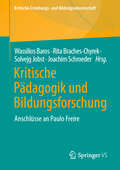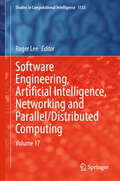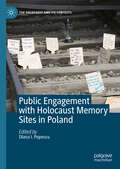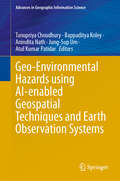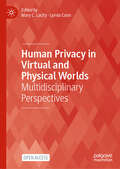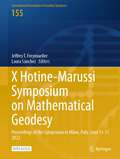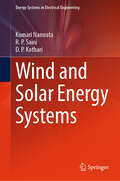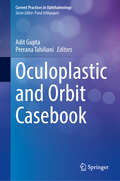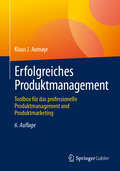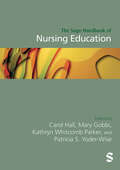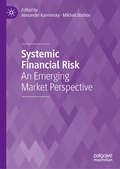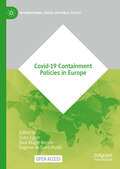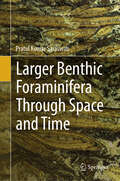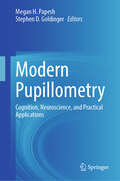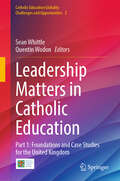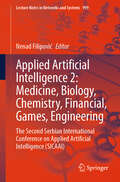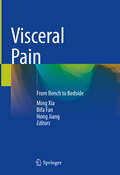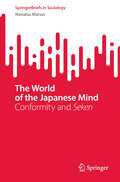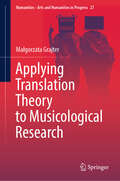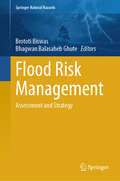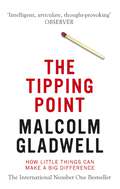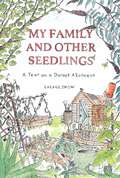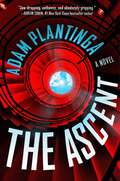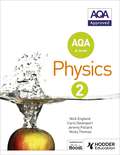- Table View
- List View
Kritische Pädagogik und Bildungsforschung: Anschlüsse an Paulo Freire (Kritische Erziehungs- und Bildungswissenschaft)
by Rita Braches-Chyrek Joachim Schroeder Wassilios Baros Solvejg JobstDer Band greift theoretische und methodische Ansätze Paulo Freires auf, dessen Kampf für Gerechtigkeit und Solidarität beispielhaft für eine radikale Kritik am bestehenden, postkolonialen neoliberalen System ist. In der Auseinandersetzung mit Freires Position der kritischen Erziehungswissenschaft eröffnen sich neue, die bisherigen Grenzen überschreitende Möglichkeiten.
Software Engineering, Artificial Intelligence, Networking and Parallel/Distributed Computing: Volume 17 (Studies in Computational Intelligence #1153)
by Roger LeeThis book reports state-of-the-art results in Software Engineering, Artificial Intelligence, Networking and Parallel/Distributed Computing. This edited book presents original papers on both theory and practice. It addresses foundations, state-of-the-art problems and solutions, and crucial challenges.
Public Engagement with Holocaust Memory Sites in Poland (The Holocaust and its Contexts)
by Diana I. PopescuThis book aims to address a neglected field of research by providing evidence-based insights into how contemporary visitors of different national and generational background, especially those of Polish and Jewish descent, experience and reflect on their visits, or on living in the proximity of different sites of memory across Poland, including former concentration and death camps, ghetto sites, and other physical sites such as museums with a connection to the Holocaust.
Geo-Environmental Hazards using AI-enabled Geospatial Techniques and Earth Observation Systems (Advances in Geographic Information Science)
by Jung-Sup Um Tanupriya Choudhury Bappaditya Koley Anindita Nath Atul Kumar PatidarThis edited collection provides a comprehensive exploration of cutting-edge ideas, approaches, simulations, evaluations of risk, and systems that enhance the practicality of current geospatial technologies for reducing hazard risks. The various sections within this book delve into subjects such as the foundational principles of Earth Observation Systems (EOS) and geospatial methodologies. Additionally, the text serves as an advisory resource on the collaborative use of satellite-derived data and artificial intelligence to track and alleviate geo-environmental threats. The volume imparts extensive understanding regarding geo-environmental dangers and their analysis via EOS along with geospatial strategies. It encompasses key hazard-related themes including coastal degradation, predisposition to landslides, mapping vegetation coverages, tropical storm patterns, soil depletion due to erosion processes, vulnerability to rapid or extended flooding events, variations in oceansurface temperatures alongside chlorophyll-a levels; it also addresses assessments related to groundwater reserves and quality measures as well as sustainable management practices for watersheds that support community livelihoods—all through leveraging AI-integrated geospatial tools in conjunction with earth observation technologies. Furthermore, this work engages in discourse about systems designed for mitigating these ecological challenges sustainably. Scholars engaged in research activities; educational professionals; those involved in landscape design; engineers working at ground level; individuals responsible for policy-making—all who are concerned with geo-environmental hazards or associated domains—will find valuable insights within these pages.
Human Privacy in Virtual and Physical Worlds: Multidisciplinary Perspectives (Technology, Work and Globalization)
by Mary C. Lacity Lynda CoonThis open-access book is premised on the belief that understanding and protecting privacy requires a multidisciplinary approach. The editors of this contributed book believe that privacy is a ‘wicked problem’ because of its social complexity. In the modern world, political, social, and technological structures increasingly violate human privacy in physical and virtual spaces. Our behaviors are surveilled, captured, and monetized—often without our knowledge. Contributors are experts from diverse fields, including anthropology, architecture, data science, engineering, history, information systems, library sciences, medicine, philosophy, and supply chain management, each writing for an explicitly interdisciplinary readership. Privacy as a concept is a moving target across the globe, morphing and transforming historically from one epoch to the next. By moving beyond the limitations of a single disciplinary lens, this book aims at a richer, more comprehensive, and more lasting analysis. This collection is of great interest to students and scholars of diverse backgrounds studying human privacy.
X Hotine-Marussi Symposium on Mathematical Geodesy: Proceedings of the Symposium in Milan, Italy, June 13-17, 2022 (International Association of Geodesy Symposia #155)
by Jeffrey T. Freymueller Laura SánchezThis open access volume contains the proceedings of the X Hotine-Marussi Symposium on Mathematical Geodesy which was held from 13 to 17 June 2022 at the Politecnico di Milano, Milan, Italy. Since 2006 the series of the Hotine-Marussi Symposia has been under the responsibility of the Inter-Commission Committee on Theory (ICCT) within the International Association of Geodesy (IAG). The ICCT organized the last five Hotine-Marussi Symposia held in Wuhan (2006), Rome (2009, 2013 and 2018), and Milan (2022). The overall goal of the ICCT and Hotine-Marussi Symposia has always been to advance geodetic theory which is indeed documented by the 22 research articles published in these proceedings. The jubilee X Hotine-Marussi Symposium was organized in 10 topical sessions covering all parts of geodetic theory including reference frames, gravity field modelling, adjustment theory, height systems, time series analysis, or advanced numerical methods. In total, 60 participants attended the Symposium who delivered 62 oral and 18 poster presentations. During a special session, five invited speakers discussed two basic concepts of physical geodesy – geoid and quasigeoid.
Wind and Solar Energy Systems (Energy Systems in Electrical Engineering)
by D. P. Kothari Kumari Namrata R. P. SainiThis book is designed to serve as a textbook for courses on renewable energy technology tragetted at upper undergraduate or graduate students. This book can also be used as a core or supplementary text for courses in energy conservation and management and solar photo-voltaic design and application. This textbook covers the basic concepts of renewable energy resources, especially wind and solar energy. It contains 8 chapters covering all major renewable energy systems, resources, and related topics, as well as a brief introductory chapter on grid integration techniques in solar and wind energy systems. The book includes pedagogical features like examples and review questions and multiple choice questions to help the readers test their understanding. Reading lists, including web-based material, are included at the end of each chapter. The structure and pedagogy makes this book useful for self-study as well as for classroom use. The book can also be used as text for professional development courses for engineers employed in the energy industry.
Oculoplastic and Orbit Casebook (Current Practices in Ophthalmology)
by Adit Gupta Prerana TahilianiThe book provides case-based approach to learning oculoplastic and orbit pathologies and tumors. It is divided into 4 categories; eyelid, orbit, lacrimal and aesthetics. Each category covers 5-10 commonly seen clinical conditions elaborated in a lucid way to understand the clinical approach and plan management of the condition. Chapters also cover the recent advances in the field.The book is helpful for ophthalmology residents, oculoplasty fellows, practicing ophthalmologists, vision science researchers and general ophthalmologists.
Erfolgreiches Produktmanagement: Toolbox für das professionelle Produktmanagement und Produktmarketing
by Klaus J. AumayrLernen Sie in diesem Buch alles über professionelles ProduktmanagementWenn Sie Ihre Produkte schon immer aktiv vermarkten wollten, ist dieses Buch genau richtig für Sie. Diese Tool-Box für das professionelle Produktmanagement und Produktmarketing hält, was sie verspricht – hier erhalten Sie eine umfassende, unverzichtbare und bewährte Arbeitshilfe. Klaus Aumayr zeigt, wie Sie die immer komplexer werdenden Aufgaben und Anforderungen an Produktmanager optimal bewältigen. Meistern Sie souverän die komplexen Aufgaben des ProduktmanagementsÜber den Erfolg eines Produkts entscheiden in erster Linie die Käufer – aber auch der verantwortliche Produktmanager. Oft kämpft er an mehreren Fronten auf einmal, und muss zum Beispiel: mit sinkenden Budgets immer mehr Produkte in immer kürzerer Zeit einführen und betreuen undgleichzeitig eine Fülle von Anforderungen aus den internen Abteilungen koordinierenMit seinem Buch „Erfolgreiches Produktmanagement“ liefert Klaus Aumayr das komplette Rüstzeug, um diese komplexen Aufgaben im Kaufprozessmanagement souverän zu meistern. Er verrät nicht nur wichtige Grundlagen, sondern auch einige praktische Produktstrategien. Außerdem erleichtern Fallbeispiele, Charts und Checklisten den Transfer in die Praxis. Der Inhalt im ÜberblickDas Buch „Erfolgreiches Projektmanagement“ behandelt die folgenden drei Schwerpunktbereiche:Produktmanagement: Positionierung, Kernkompetenzen und organisatorische EinbindungProduktmarketing: Strukturen, Erfolgsfaktoren und praktische HilfsmittelProzessorientiertes Produktmanagement: Arbeitsprozesse, Prozessorientiertes Produktmarketing und InnovationsmanagementDie sechste Auflage wurde überarbeitet und aktualisiert. Ein Abschnitt zu Rollen des Produktmanagements, das KANO-Modell sowie die Gewichtungs-Bewertungsmatrix wurden aufgenommen und das agile Produktmanagement wird nun ausführlicher behandelt.
The Sage Handbook of Nursing Education
by Carol Hall Patricia S. Yoder-Wise Mary Gobbi Kathryn Whitcomb ParkerIn the past several years, a revival of research devoted to nursing education has emerged. This emergence has changed the way many educators engage in their practice of working with learners; and learners have come to expect that they will have a rich learning experience designed to develop new (or enhance prior) knowledge, skills, and attitudes. The SAGE Handbook of Nursing Education provides a detailed map of the current discipline, with a carefully selected team of international contributors offering the latest thinking about education in nursing across key areas. This handbook will be a key resource for academic educators, as well as graduate and postgraduate learners.
The Sage Handbook of Nursing Education
by Carol Hall Patricia S. Yoder-Wise Mary Gobbi Kathryn Whitcomb ParkerIn the past several years, a revival of research devoted to nursing education has emerged. This emergence has changed the way many educators engage in their practice of working with learners; and learners have come to expect that they will have a rich learning experience designed to develop new (or enhance prior) knowledge, skills, and attitudes. The SAGE Handbook of Nursing Education provides a detailed map of the current discipline, with a carefully selected team of international contributors offering the latest thinking about education in nursing across key areas. This handbook will be a key resource for academic educators, as well as graduate and postgraduate learners.
Systemic Financial Risk: An Emerging Market Perspective
by Alexander Karminsky Mikhail StolbovThis book provides an analysis of various sources and forms of systemic financial risk. It focuses on the most pressing research questions for both advanced and emerging market economies, including green finance, ESG agenda and related risks, international financial connectivity across countries and financial institutions, and catastrophic risks modeling. Part 1 considers emerging research issues in risk assessment and management, including new approaches to measuring financial development, trends and prospects of green finance, and cross-country financial spillovers. Part 2 casts a more nuanced look at the quantitative models and methods adopted in risk assessment and risk management, putting such issues as measuring catastrophic risks, liquidity mismatches as well as modeling probabilities of default and the impact of macroeconomic fundamentals on capital adequacy ratios in the Russian banking sector in the spotlight. Finally, Part 3 discusses the new regulatory challenges dealingwith risk assessment and risk management, such as macroprudential policies which have proved efficient to mitigate systemic risk are investigated. The book offers a comprehensive picture of the challenges which emerging market economies are facing in the field of financial risk assessment and management. Specifically, the challenges are discussed in the context of elaborated models and policy responses, which are based on the up-to-date theoretical contributions and empirical evidence from various fields, making the book relevant to professors, researchers, graduate students, and practitioners of risk management, international finance, and financial services.
Covid-19 Containment Policies in Europe (International Series on Public Policy)
by Clara Egger Raul Magni-Berton Eugénie de Saint-PhalleThis open access book examines the diverse strategies implemented by national and local European governments to contain the Covid-19 pandemic. Rather than focus on individual national case studies, it brings together leading scholars and policymakers to analyse the wide range of containment policies utilised across the continent at various levels of government. In doing so, the volume assesses Covid-19 crisis-management experiences to identify good practices based on comparative and fine-grained evidence. It argues that such a stock-taking exercise is crucial to better prepare European polities and societies for future crises, including climate change and environmental disasters. The book will appeal to scholars and students of public policy, crisis-management, public administration, international relations and comparative law.
Larger Benthic Foraminifera Through Space and Time
by Pratul Kumar SaraswatiForaminifera are single-celled marine organisms, usually less than a millimeter in size, and their fossil records extend back in geological time some 500 million years. Some foraminifera have grown to over 10 centimeters; these are informally called "larger benthic Foraminifera" (LBF). LBF are of outstanding value in field and in laboratory experiments. They can serve as geochemical proxies and can be used to learn about biology, biomineralization process, and more. Their study finds wide-ranging geological applications, including the carbonate platforms' past environmental changes and stratigraphy. There are many books on micropaleontology, fewer on Foraminifera and practically none on LBF. The ones that do exist are generally too specialized for micropaleontology and carbonate sedimentology doctoral students to utilize. This volume aims to fill this gap by providing readers with an understanding of the morphology and distribution of LBF in space (environment) and time (evolution). In addition, the isotope and trace metal proxies in LBF are discussed for paleoclimate reconstruction. This volume will benefit researchers and professionals in micropaleontology, hydrocarbon exploration, carbonate sedimentology, and paleoclimate.
Modern Pupillometry: Cognition, Neuroscience, and Practical Applications
by Megan H. Papesh Stephen D. GoldingerPupillometry, the study of the eyes’ pupils, has a rich history, dating back to the 1800s. For example, to appear “dark with desire,” women once used atropa belladonna (deadly nightshade) as a cosmetic, because the atropine dilated their pupils, making them appear more romantically aroused. We now know that this relationship is largely driven by the activity of the sympathetic nervous system; specifically, a small brainstem nucleus known as the locus coeruleus (LC). Because of tight connections between the musculature of the eyes and LC, monitoring the pupils can reveal important insights into brain activity during mental processes. Many of these processes are related to attention and arousal (cognitive or emotional), with the LC controlling mental readiness via secretion of the neurotransmitter norepinephrine. While these complicated neurochemical processes happen in the brain, they are often overtly observable via pupil dilation. Although pupillometry was popular in the 1960s and 1970s, it fell out of favor until experiencing a renaissance approximately 10 years ago. With the advent of new eye-tracking and neural recording technology, measuring (and analyzing) pupil size is now easier than ever. Because all modern eye-trackers use pupil size in the calculation of gaze location, they also provide researchers with moment-by-moment pupil size measures in output files. Although previously considered “extra” data to support gaze location analyses, researchers have begun to conduct eye-tracking studies solely to gain access to pupil size data. These data have been used to study thought processes in many domains, including cognitive science, psychopathologies, business/marketing, security contexts, and the study of addiction. The diversity of interest in pupillometry is matched by the diversity in approaches taken to data collection, analysis, and interpretation. To date, there exists no book or tutorial review devoted specifically to ensuring that researchers carry out rigorous and reproducible work across these varied domains. Modern Pupillometry: Cognition, Neuroscience, and Practical Applications fills this gap by exploring the history, neuroscience, and methodological considerations of pupillometry research within and beyond psychology.
Leadership Matters in Catholic Education: Part 1: Foundations and Case Studies for the United Kingdom (Catholic Education Globally: Challenges and Opportunities #2)
by Quentin Wodon Sean WhittleThis edited collection is the first part of a two-volume set., which focuses on leadership in Catholic education settings in the United Kingdom. It includes an overview of the importance of different types of leadership, including ‘servant-leadership’, in understanding and framing Catholic school practice, a critical survey of why leadership matters to ensuring the success of Catholic education, and a discussion of what counts as the defining characteristics of leadership in Catholic education and how this relates to the aims or philosophy of Catholic education. The chapters in this book draw from the insights and experiences of serving Catholic school leaders as well as from academics and researchers in Catholic education studies. The final two chapters provide a comparative analysis for the United Kingdom in a global perspective using data from the Organisation for Economic Co-operation and Development (OECD) . Together, the chapters argue that there is an urgent need to find, nurture, and sustain outstanding leaders for Catholic schools and colleges.
Applied Artificial Intelligence 2: The Second Serbian International Conference on Applied Artificial Intelligence (SICAAI) (Lecture Notes in Networks and Systems #999)
by Nenad FilipovićThe book Applied Artificial Intelligence 2: Medicine, Biology, Chemistry, Financial, Games, Engineering is providing exceptional chapters of the state-of-the-art research knowledge and results on the innovative theories, methodology and applications of artificial intelligence and its sub-domain like deep learning, machine learning in different areas such as medicine, economy, education, law, smart city, government, industry etc. Innovative research ideas on how to solve problems using artificial intelligence, both in R&D and real-time applications are presented. Chapters describe the advanced prototypes, systems, methodologies, tools and techniques and general survey papers, which indicate future directions. These Chapters are extended papers from the Second Serbian International Conference on Applied Artificial Intelligence (SICAAI), which was held in Kragujevac, Serbia, on May 19-20, 2023
Visceral Pain: From Bench to Bedside
by Hong Jiang Ming Xia Bifa FanPatients with chronic visceral pain present a challenge for medical providers because of their vague presenting symptoms and frequent lack of identifiable pathology. Despite this, chronic visceral pain can be a debilitating medical condition that increases morbidity and decreases quality of life; the long-term consequences of which cause significant socioeconomic burden and debility. Covering the newest trends, studies, diagnosis and treatments in visceral pain care, as well as the pain treatment strategies that have been successfully employed in the past, this book brings readers fully up to date with effective recognitions and treatments for visceral pain. The clinical evaluation and presentation of common chronic visceral pain conditions and multimodal treatment options that can be used to assist patients and providers are focused.
The World of the Japanese Mind: Conformity and Seken (SpringerBriefs in Sociology)
by Noriatsu MatsuiThis book investigates the source from which the pressure to conform arises in Japanese society. Even though the contemporary Japanese word for “society” (Shakai) has a history of 140 years, it does not include the concept of respecting the individual but refers mainly to social frameworks and institutional aspects. At the same time, the traditional Japanese terms for “society”, primarily Seken, that have been in use for 1,400 years have embraced human relationships of the members of the group.The hypothesis of this book is that there is no “society” as such in Japanese people’s minds. By proposing a new model (the Hand-Carved Tripod Model) of conformity in Japan, the book shows the structure of the pressure to conform. The tripod is composed of ambiguous words, the sense of belonging, and the “air”, or understanding, that represents the unwritten rules and regulations of Seken.Conformity in Japanese people’s minds takesdifferent forms, from small residential groups to corporations at work, and to nationwide associations, but always dictates that people follow everyone else in the organization.This book examines the sense of being blocked in Japan that has prevailed over 30 years, during the period of the so-called Three Lost Decades in Japan. Examining phenomena such as low worker engagement, karoshi (death by overwork), high middle-age male suicide rates, bullying in school and at work, sex discrimination, hereditary membership in the Diet, and failure to provide adequate protection for whistle-blowers, this book reveals a common structure in Japanese minds: lack of respect for individuality, and the traditional and narrow sense of the world, i.e., Seken.This book will be beneficial to scholars and graduate students as well as to businesspeople who are interested in understanding the behavior and minds of Japanese people from the psychological,cultural, and historical viewpoints. It provides an integrated view of Japan’s Seken as the platform that generates their conformity.
Applying Translation Theory to Musicological Research (Numanities - Arts and Humanities in Progress #27)
by Małgorzata GrajterThis monograph lays the foundation for new methodologies of research between music and translation. It is the first such holistic attempt—from the perspective of a musicologist—based on the adaptation of translation theories. Until now, these fields have remained underexplored together. Only recently have the tools developed by translation theory permeated into musical scholarship. Such tools should prove as a promising alternative to those offered by classic musicological studies, particularly in reference to musical arrangement, pop music covers and performance. Theoretical discussion on topics are supported by case studies. This text appeals to musicologists and musicians as well as experts in the field of translation theory who are interested in expanding their field of inquiry.
Flood Risk Management: Assessment and Strategy (Springer Natural Hazards)
by Brototi Biswas Bhagwan Balasaheb GhuteThis book examines the nature of flood in different landscapes and the various factors that contribute to flooding in different areas. It identifies flood risk zones in different terrain types and provides valuable insights into the anthropogenic, geographical, hydro-geological, and geomorphological aspects of flood-prone areas to achieve sustainable risk management. The book also explores the impact of avalanches, global warming, and flash floods in different settings where such types of flooding have become more common. In addition, the volume provides case studies to evaluate the impact of flooding in both natural and man-made environments. To better understand and manage floods, the book combines advanced geospatial tools and techniques with indigenous knowledge. Using machine learning and multiple-criteria decision analysis, the book provides an amalgamation of technology and indigenous knowledge to assess flood susceptibility. The book also includes strategies to manage flood risks and case studies that demonstrate best practices in flood risk management. The volume is a valuable resource for researchers, students, and policy makers to understand the causes of floods and their socio-economic impact in different areas.
The Tipping Point: How Little Things Can Make a Big Difference
by Malcolm Gladwell'A wonderful page-turner about a fascinating idea that should affect the way every thinking person thinks about the world around him' Michael LewisIn this brilliant and original book, Malcolm Gladwell explains and analyses the 'tipping point', that magic moment when ideas, trends and social behaviour cross a threshold, tip and spread like wildfire. Taking a look behind the surface of many familiar occurrences in our everyday world, Gladwell explains the fascinating social dynamics that cause rapid change.'Hip and hopeful, THE TIPPING POINT is like the idea it describes: concise, elegant but packed with social power. A book for anyone who cares about how society works and how we can make it better' George Stephanopoulos
My Family and Other Seedlings: A Year on a Dorset Allotment
by Lalage SnowA few years ago Lally Snow moved to a Dorset village with her husband and three small children, having spent over a decade as a war photographer, foreign correspondent and film maker living in Kabul. She covered the conflict there as well as other wars from Gaza to Eastern Ukraine, and Iraq.In the late winter of 2021-22, Lally decided to rent an allotment, despite having only a rudimentary knowledge of gardening. She was starting from scratch and setting herself the dual challenge of growing an allotment at the same time as growing a family.This is a heart-warming, wry and at times tearful account of Lally's travails as a mother and novice allotment holder, counterpointing horticultural progress with the perils of parenting. Along the way she reflects on the drudgery of English rural domesticity after a professional life chasing war and adventure, the history of the allotment since Saxon times, and the wonderful moment when gardening becomes fun rather than just feeding a family.
The Ascent
by Adam PlantingaWhen a high security prison fails, a down-on-his luck cop and the governor&’s daughter are going to have to team up if they&’re going to escape in this "jaw-dropping, authentic, and absolutely gripping" (Harlan Coben, #1 New York Times bestselling author) debut USA Today bestselling thriller from Adam Plantinga, whose first nonfiction book Lee Child praised as &“truly excellent.&” Kurt Argento, an ex-Detroit street cop who can&’t let injustice go—and who has the fighting skills to back up his idealism. If he sees a young girl being dragged into an alley, he's going to rescue her and cause some damage. When he does just that in a small corrupt Missouri town, he&’s brutally beaten and thrown into a maximum-security prison. Julie Wakefield, a grad student who happens to be the governor's daughter, is about to take a tour of the prison. But when a malfunction in the security system releases a horde of prisoners, a fierce struggle for survival ensues. Argento must help a small band of staff and civilians, including Julie and her two state trooper handlers, make their way from the bottom floor to the roof to safety. All that stands in their way are six floors of the most dangerous convicts in Missouri.
AQA A Level Physics Student Book 2
by Nick England Jeremy Pollard Nicky Thomas Carol DavenportExam Board: AQALevel: AS/A-levelSubject: PhysicsFirst Teaching: September 2015First Exam: June 2017AQA ApprovedExpand and challenge your students' knowledge and understanding of Physics with textbooks that build mathematical skills, provide practical assessment guidance and support for all 5 topic options.- Provide support for all 5 topic options: Astrophysics is covered in the book, with Turning Points in Physics, Engineering Physics, Medical Physics and Electronics available to download online.- Offers guidance for the mathematical requirements of the course with worked examples of calculations and a dedicated 'Maths in Physics' chapter- Measures progress and assess learning throughout the course with Test Yourself and Stretch and Challenge Questions to extend the most able pupils beyond A-level- Supports all 12 required practicals with applications, worked examples and activities included in each chapter- Develops understanding and enable self- and peer-assessment with free online access to 'Test yourself' answers.DOWNLOADABLE OPTION TOPIC CHAPTERS To request your downloadable copies please email science@hodder.co.uk.
